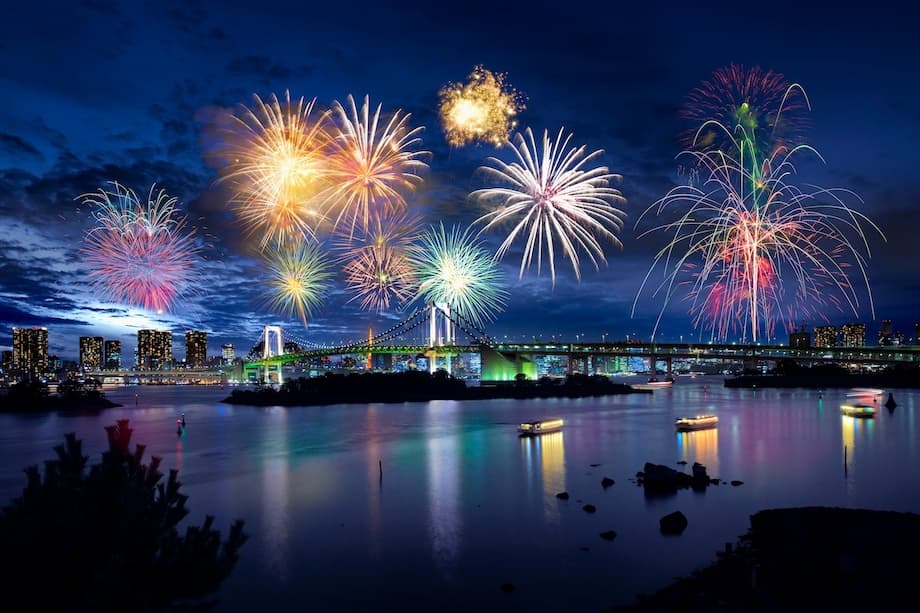Season shift in Tokyo
September in Tokyo feels like a bridge between two moods. The last of the summer heat lingers during the day, often pushing temperatures above 30°C, while evenings start to feel kinder with a light breeze. Humidity remains high, and sudden showers arrive without much warning. Meteorologists class September as part of typhoon season, so visitors do well to pack a compact umbrella or light rain jacket and to keep an eye on forecasts. The city continues to buzz after a packed summer, then gradually slides toward a calmer, autumn rhythm. Holiday weekends around Respect for the Aged Day and the autumn equinox bring extra foot traffic at popular sights and events.
This is also one of the most interesting months for outdoor life in the capital. Night skies brighten with late fireworks festivals, gardens roll into peak bloom for early fall flowers, and shrines across the city host lively matsuri that fill streets with drums, chants, and portable shrines. At the same time, major cultural and entertainment events move indoors, from a two week sumo tournament to a global gaming expo. The range is wide, and the schedules are dense, which makes a little planning pay off for first time visitors and long time residents alike.
Tokyo Festival 2025 brings the city on stage
Running from September 1 to November 3, Tokyo Festival 2025 turns the capital into a broad stage for performing arts. Programming stretches across neighborhoods and venues such as Tokyo Metropolitan Theatre and Tokyo International Forum. International theater and dance companies share the calendar with Japanese creators. The lineup blends classic works with experimental productions, along with site specific and interactive pieces that move out of conventional auditoriums and into public spaces. This format suits September well, inviting people to catch an afternoon show after a garden visit or to book a late performance after a shrine festival.
English friendly performances are common, either through surtitles or language free productions. Families can often find shorter works that welcome children. Tickets appear in tiers from affordable seats to premium categories, and same day sales sometimes pop up for less crowded shows. For dates, venues, and language support, the city’s official guide keeps a concise overview at GoTokyo. The festival’s citywide format also makes it easy to combine arts with nearby dining, from casual street stalls around Ikebukuro to sleek restaurants near Hibiya and Marunouchi.
Autumn flowers and serene gardens
September opens the autumn flower calendar in and around Tokyo. The stars are fields of cosmos in lively pinks and oranges, and the purple and white drifts of hagi, or bush clover. These displays usually pair well with temperate mornings and golden hour strolls, offering both quiet time and good photo conditions. Crowds thin on weekday mornings, and many parks allow bicycle rentals for leisurely exploration.
Cosmos Festival at Showa Kinen Park
Showa Kinen Park in Tachikawa, a short train ride west of central Tokyo, stages one of the largest seasonal displays with around four million cosmos flowers across expansive fields. Blooms run from mid September into October, with color waves that shift by variety and planting zone. The park spans lawns, water features, and wooded paths, so it is easy to build a full day around the flowers. Bring a hat and water for the warmer mid day hours. The park charges modest entry, and rental bicycles help cover distance between the cosmos fields, Japanese Garden, and the ginkgo lined promenade that begins to yellow later in the season.
Hagi tunnel at Mukojima Hyakkaen
Mukojima Hyakkaen Garden in Sumida offers a quieter, more contemplative scene. Its 30 meter hagi tunnel forms a delicate arch over a narrow path as the clover blooms in soft purples and whites. The garden dates back to the Edo period and keeps a literary theme with seasonal plantings. Visitors linger for the gentle light and the sense of enclosure the tunnel creates. Tripods are often restricted, and staff may direct foot traffic during peak bloom to protect plantings. Early morning and late afternoon tend to give the best light for photos while keeping the garden mood relaxed.
Beyond Tokyo: red spider lilies near the city
Day trippers with time to spare can head to Kinchakuda Manjushage Park in Hidaka, Saitama. Trails weave through a floodplain forest carpeted with millions of red spider lilies from mid September to early October. The route from Tokyo is straightforward by train, and the site manages crowd flow on busy weekends. Comfortable walking shoes and a bit of patience go a long way on peak days.
Fireworks return to the night sky
September fireworks bring a late encore to the summer season. Compared with July and August shows, these nights feel cooler and slightly less humid, which makes an evening along the river pleasant if the weather holds. Programs often use synchronized music and choreographed sequences that build to large burst finales. Many shows sell reserved seating that includes timed entry gates, while free viewing areas fill quickly several hours before the first launch.
Chofu City Fireworks Festival usually draws huge crowds to the Tamagawa riverside. Recent editions feature around ten thousand shells with themed segments and a grand closing sequence. The local government publishes spectator maps, including family areas and zones for tripod use. Rail lines add extra trains after the finale, yet platforms can still be crowded. Packing light and plotting an exit route in advance can shave time off the trip back to the center.
The Kita City Fireworks Festival along the Arakawa River sets off around ten thousand fireworks paired with music and lighting. Organizers also stage an artistic fireworks showcase that highlights special shell designs and timing. The broad riverbank offers multiple vantage points, and paid seating cuts down on the stress of securing a spot. Bring a light jacket for the breeze off the water and keep an eye on the forecast on the day of the event.
Shrines, streets, and living traditions
September matsuri in Tokyo bring together community pride, Shinto ritual, and a carnival spirit. Streets fill with teams carrying mikoshi, portable shrines, on their shoulders, moving to drums and whistles. Food stalls serve yakisoba, grilled corn, taiyaki, and seasonal sweets. This is a good time to see traditional dance, court music, and period costume parades that reflect centuries of local history. Visitors are welcome, and it helps to step aside for processions and to ask before photographing people at close range.
Nezu Jinja Annual Grand Festival dates back to 1714 and transforms the historic shrine precinct with music, dances, and stalls. The event often includes bugaku court dance and ceremonies that honor the shrine’s deities. The surrounding Bunkyo neighborhood joins in with lanterns and street food, creating a festive atmosphere without losing the shrine’s dignified feel. The shrine grounds are compact, so visiting earlier in the day avoids the tightest crowds.
Shinagawa Shukuba Matsuri celebrates the area’s past as the first post town on the old Tokaido road between Edo and Kyoto. Local residents dress in period costume for a parade that brings Edo era street life to the present. Children enjoy the performances and the simple games set up along the main route. The event typically runs in late September and sits close to other attractions like Sengakuji Temple, which makes it easy to build a day around the district.
Fukuro Matsuri in Ikebukuro has run since 1968 and pulls tens of thousands into the station area. The September portion centers on a mikoshi parade with lion dances and traditional hayashi music. A companion Tokyo Yosakoi dance festival takes place in October, so late month visitors can catch the handover between the two parts. Ikebukuro’s dining scene absorbs the crowds well, from quick noodles to izakaya stretches on side streets.
Across the city you will also find neighborhood favorites that define early autumn weekends. These vary by date each year, but the flavor remains consistent.
- Akasaka Hikawa Matsuri fills streets around Hikawa Shrine with floats, Bon Odori dance, and street food.
- Setagaya Hachimangu Aki Matsuri features drum performances, mikoshi processions, and a community sumo event.
- Kichijoji Autumn Festival brings multiple portable shrines together near Musashino Hachimangu Shrine.
- Kaminarimon Bon Odori in Asakusa invites everyone to join the circle dance beneath lanterns by the famous gate.
- Daradara Matsuri in the Daimon area stretches across many days with markets, music, and processions.
- Nakanobu Yosakoi showcases energetic dance teams from across Tokyo and beyond.
Big stages and stadium nights
The September Grand Sumo Tournament returns to Ryogoku Kokugikan from September 14 to 28, 2025. The 15 day schedule runs daily bouts from morning lower division matches to top division clashes in the late afternoon. Ticket demand is high. Box seats sell out quickly when sales open, and even single seats for weekend days are scarce. Weekdays are easier. The arena’s museum is a helpful add on for first timers, laying out the sport’s origins and rituals that play out on the dohyo.
Tokyo Game Show takes over Makuhari Messe from September 25 to 28, with separate business and public days. Major publishers share space with indie creators, and families often plan around the cosplay, retro game areas, and free trial sections. Comfortable shoes are essential. Queues build for the most hyped demos, and announcements spill from stages and stream online. Budget time for the train ride to and from Chiba, and check crowd levels for the public weekend days.
The World Athletics Championships Tokyo 25 begins on Saturday, September 13, with an opening ceremony inside Japan National Stadium. The program features Kodo’s taiko drummers, the national anthem sung by Tomotaka Okamoto, a welcome by World Athletics President Sebastian Coe, a host city address by Tokyo Governor Yuriko Koike, and an opening declaration by Crown Prince Akishino. The ceremony is open to those with tickets for the evening session that day. The championships place Japanese culture on a global stage and will draw large crowds on transport lines serving the stadium.
Music, food, and niche gatherings
Electronic music fans circle Ultra Japan on September 13 and 14 at Odaiba, where international headliners play across multiple stages. The skyline setting, LED production, and festival atmosphere draw both domestic and overseas visitors. Tickets come in single day and two day options. Entry checks are thorough, and bag sizes are limited, so check the latest guidance before arrival.
Shiba Park hosts an Oktoberfest from September 12 to 23, pouring a wide range of German brews alongside sausages, pretzels, and live folk performances. Families tend to visit earlier in the day, with livelier crowds at night and on weekends. Admission fees are modest, and the setting under Tokyo Tower makes for easy photos. The event sits near central rail lines, which helps with crowd dispersal at closing time.
Art, collectibles, and streetside culture also take a bow in September. Antique hunters prowl the Oedo Antique Market and the Hanazono Shrine Antique Market for ceramics, textiles, and vintage finds. Local events such as Japan Fes Tokyo fill park spaces with booths for street food and live music. Neighborhood exhibitions and citywide programs span from high fashion retrospectives and contemporary installations to family friendly pop culture shows. The calendar includes Roppongi Art Night, Issey Miyake’s Folded Forms, Moomin anniversary exhibits, and themed pop up cafes that dot the city from Shibuya to Hibiya.
A September footnote worth noticing came just at the month’s start in Shibuya. A partnership between Bank Indonesia’s Tokyo office and a local cafe hosted Papua Coffee Week, introducing beans from several regions and piloting cross border QRIS digital payments for direct purchases. Visitors could scan using Indonesian QR codes in Japan, a small peek at how regional cashless systems are starting to talk to each other. The event wrapped on September 1, yet it mirrors a wider trend at food and culture fairs around the city where small vendors experiment with simpler payment tools.
How to plan and stay comfortable
Weather is the wild card. Build flexible plans that can shift from outdoor to indoor activities if showers move in. Parks and gardens usually remain open in light rain, and a drizzle can improve photos of flowers and lanterns. If storms or typhoons approach, firework organizers may postpone or cancel for safety. Follow official social channels and local government pages for status updates. Light layers help with transitions from humid streets to air conditioned trains and venues.
Popular events reward early bookings. Sumo tickets sell fast, and Tokyo Game Show public days fill quickly. Fireworks seating plans go on sale in advance and often require picking up wristbands or tickets. For Tokyo Festival performances, scan schedules for weekday matinees or late shows that are easier to secure. The World Athletics Championships will add pressure on lodging near the National Stadium, so consider staying along a direct rail line and commuting in rather than competing for rooms steps from the venue.
Trains are the best way to move, especially after large events. Stations add staff and run extra services for fireworks and stadium nights, but platforms still get crowded. Give yourself time, use all doors when boarding, and follow staff directions at queue lines. Coin lockers near major hubs help lighten the load. Convenience stores, found nearly everywhere, stock water, snacks, and rain gear, and they become invaluable during long outings.
A little etiquette goes far. Step aside for mikoshi processions and listen for staff guidance at shrines and gardens. Avoid eating while walking in crowded festival areas to prevent spills. Carry your trash until you find a bin or take it back to your hotel. Photography is welcome at most events, yet it pays to ask consent for close portraits. Volunteer cleanups sometimes follow weekend events, and joining one is a nice way to give back to the neighborhoods hosting the fun.
Sample day plans
Flowers and fireworks day: Start at Showa Kinen Park for cosmos fields and a relaxed picnic lunch. Ride bikes across the park to cover distance and cool off. Head back into the city for an early dinner near Chofu or along the Keio Line, then settle in on the riverside for the fireworks. Bring a compact cushion, snacks, and a light jacket for the breeze.
Sumo and museum afternoon: Arrive at Ryogoku Kokugikan by late morning to explore the onsite museum and watch lower division bouts. Break for lunch at a chanko nabe restaurant around Ryogoku, then return for the top division matches in the late afternoon. If energy remains, walk to the Edo Tokyo Museum area or along the Sumida River before dinner.
Gaming and pop culture weekend: Spend a day at Tokyo Game Show in Makuhari, reserving time for indie booths and cosplay areas in addition to the major stages. On the other day, tour anime and manga events in Shibuya and Shinjuku, or drop into a themed pop up cafe tied to a favorite franchise. Cap the night with city views from Tokyo City View or Tokyo Tower.
Tradition and dance on the streets: Time a visit for a neighborhood matsuri. Catch a morning ritual at a shrine, then follow the afternoon mikoshi route through backstreets and shopping arcades. Stop for yakitori and festival sweets, join a Bon Odori circle in the evening if invited, and finish with a stroll past lanterns framing the shrine approach.
What to Know
- September remains hot and humid in Tokyo, and showers or typhoons can affect outdoor plans.
- Tokyo Festival 2025 runs September 1 to November 3 with citywide theater, dance, and interactive works.
- Showa Kinen Park hosts around four million cosmos, and Mukojima Hyakkaen features a 30 meter hagi tunnel.
- Chofu and Kita City fireworks bring late season shows, with paid seating and crowded free areas.
- Nezu Jinja, Shinagawa Shukuba, and Ikebukuro’s Fukuro Matsuri headline shrine and street festivals.
- The September Grand Sumo Tournament runs September 14 to 28 at Ryogoku Kokugikan.
- Tokyo Game Show takes place September 25 to 28 at Makuhari Messe, with public days on the weekend.
- The World Athletics Championships opening ceremony is set for Saturday, September 13, at Japan National Stadium.
- Ultra Japan and Oktoberfest in Shiba Park add music and food options across mid September.
- Book tickets early, travel by train, and carry rain gear to stay comfortable and flexible.




